Innovation and Sustainable Business Development: A Detailed Study
VerifiedAdded on 2020/03/02
|8
|2222
|109
Essay
AI Summary
This essay explores the concept of business models, particularly focusing on innovation and sustainable business development. It discusses how businesses translate value propositions into revenue growth, emphasizing the importance of understanding the customer and delivering value at an appropriate cost. The essay highlights the impact of e-business and technological advancements on creating new value delivery methods. It further analyzes business models in terms of cost/revenue architecture, innovation, and technology management, emphasizing the interconnectedness of business model components. The study also examines the role of big data and analytics in driving business change, using RightShip as an example of a company leveraging these tools for risk management in the maritime industry. The essay concludes by underscoring the significance of understanding business models for value creation and innovation, and the necessity of approaching business model analysis with a specific business context in mind.
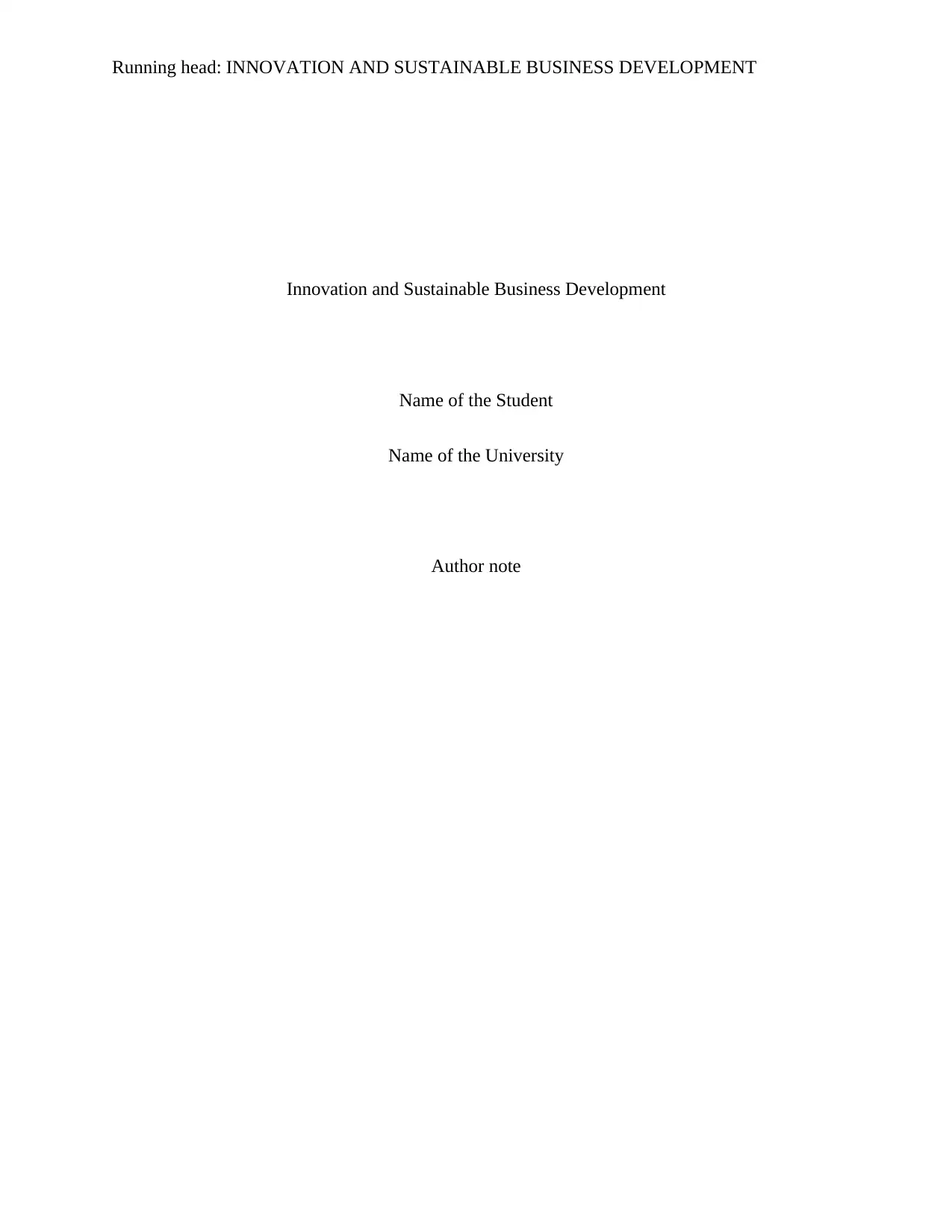
Running head: INNOVATION AND SUSTAINABLE BUSINESS DEVELOPMENT
Innovation and Sustainable Business Development
Name of the Student
Name of the University
Author note
Innovation and Sustainable Business Development
Name of the Student
Name of the University
Author note
Paraphrase This Document
Need a fresh take? Get an instant paraphrase of this document with our AI Paraphraser
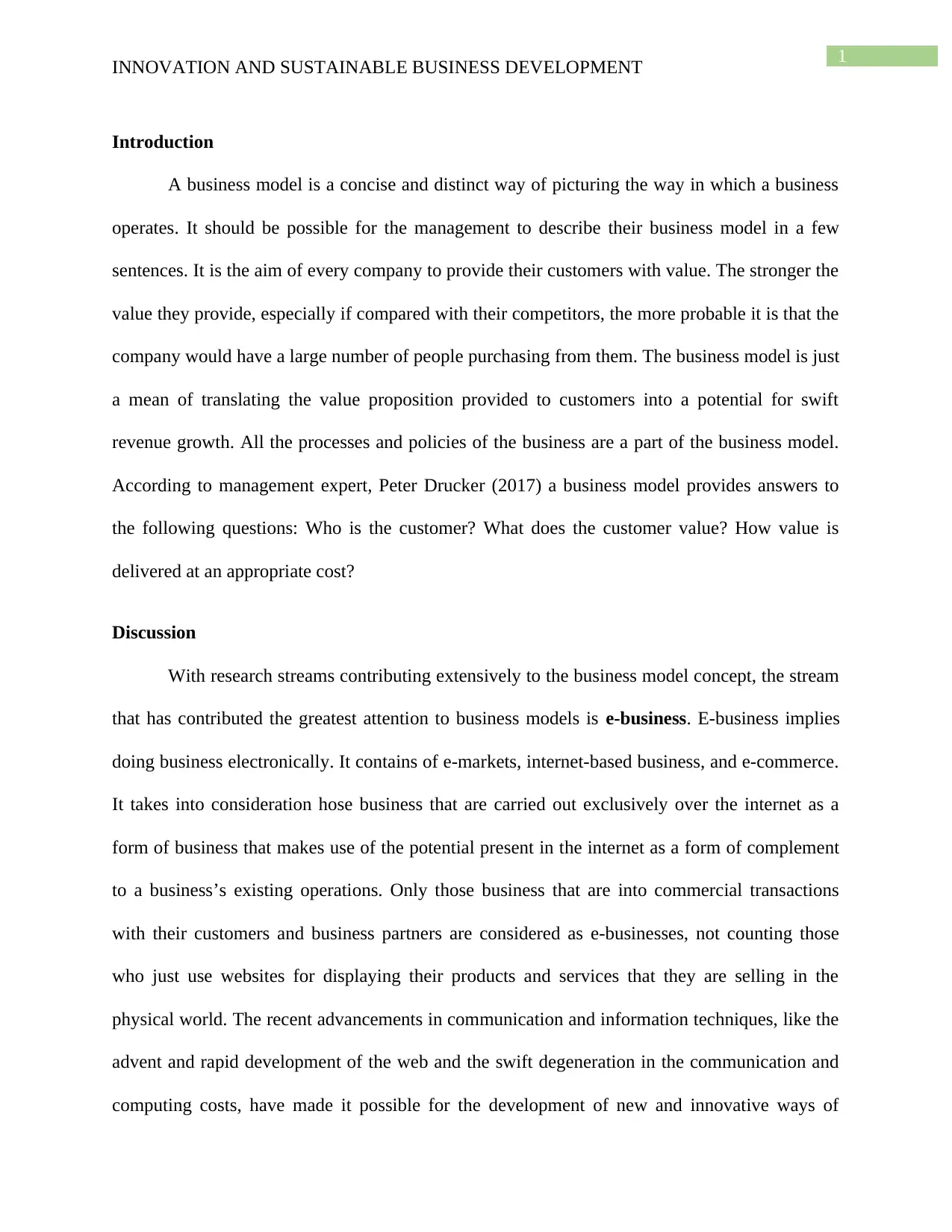
1
INNOVATION AND SUSTAINABLE BUSINESS DEVELOPMENT
Introduction
A business model is a concise and distinct way of picturing the way in which a business
operates. It should be possible for the management to describe their business model in a few
sentences. It is the aim of every company to provide their customers with value. The stronger the
value they provide, especially if compared with their competitors, the more probable it is that the
company would have a large number of people purchasing from them. The business model is just
a mean of translating the value proposition provided to customers into a potential for swift
revenue growth. All the processes and policies of the business are a part of the business model.
According to management expert, Peter Drucker (2017) a business model provides answers to
the following questions: Who is the customer? What does the customer value? How value is
delivered at an appropriate cost?
Discussion
With research streams contributing extensively to the business model concept, the stream
that has contributed the greatest attention to business models is e-business. E-business implies
doing business electronically. It contains of e-markets, internet-based business, and e-commerce.
It takes into consideration hose business that are carried out exclusively over the internet as a
form of business that makes use of the potential present in the internet as a form of complement
to a business’s existing operations. Only those business that are into commercial transactions
with their customers and business partners are considered as e-businesses, not counting those
who just use websites for displaying their products and services that they are selling in the
physical world. The recent advancements in communication and information techniques, like the
advent and rapid development of the web and the swift degeneration in the communication and
computing costs, have made it possible for the development of new and innovative ways of
INNOVATION AND SUSTAINABLE BUSINESS DEVELOPMENT
Introduction
A business model is a concise and distinct way of picturing the way in which a business
operates. It should be possible for the management to describe their business model in a few
sentences. It is the aim of every company to provide their customers with value. The stronger the
value they provide, especially if compared with their competitors, the more probable it is that the
company would have a large number of people purchasing from them. The business model is just
a mean of translating the value proposition provided to customers into a potential for swift
revenue growth. All the processes and policies of the business are a part of the business model.
According to management expert, Peter Drucker (2017) a business model provides answers to
the following questions: Who is the customer? What does the customer value? How value is
delivered at an appropriate cost?
Discussion
With research streams contributing extensively to the business model concept, the stream
that has contributed the greatest attention to business models is e-business. E-business implies
doing business electronically. It contains of e-markets, internet-based business, and e-commerce.
It takes into consideration hose business that are carried out exclusively over the internet as a
form of business that makes use of the potential present in the internet as a form of complement
to a business’s existing operations. Only those business that are into commercial transactions
with their customers and business partners are considered as e-businesses, not counting those
who just use websites for displaying their products and services that they are selling in the
physical world. The recent advancements in communication and information techniques, like the
advent and rapid development of the web and the swift degeneration in the communication and
computing costs, have made it possible for the development of new and innovative ways of
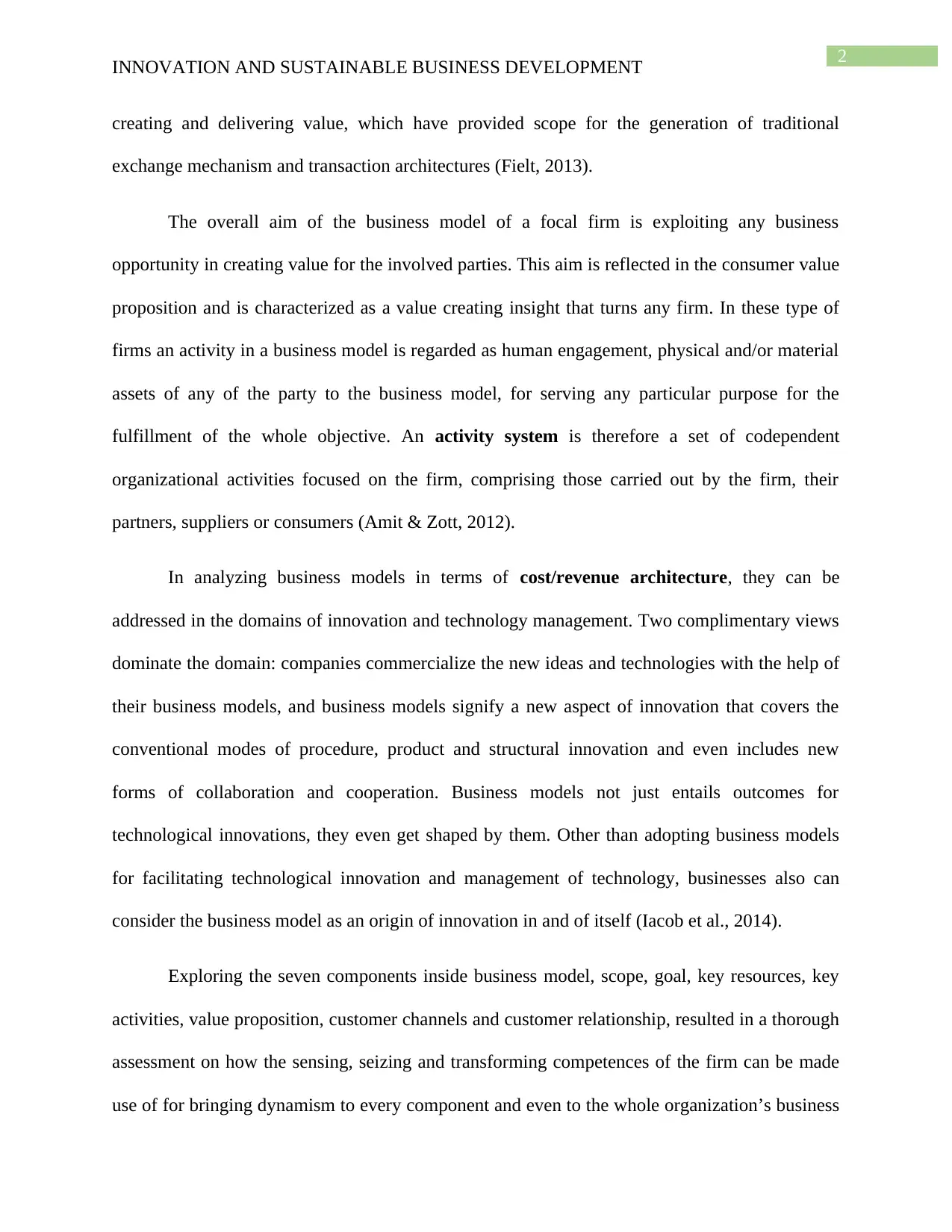
2
INNOVATION AND SUSTAINABLE BUSINESS DEVELOPMENT
creating and delivering value, which have provided scope for the generation of traditional
exchange mechanism and transaction architectures (Fielt, 2013).
The overall aim of the business model of a focal firm is exploiting any business
opportunity in creating value for the involved parties. This aim is reflected in the consumer value
proposition and is characterized as a value creating insight that turns any firm. In these type of
firms an activity in a business model is regarded as human engagement, physical and/or material
assets of any of the party to the business model, for serving any particular purpose for the
fulfillment of the whole objective. An activity system is therefore a set of codependent
organizational activities focused on the firm, comprising those carried out by the firm, their
partners, suppliers or consumers (Amit & Zott, 2012).
In analyzing business models in terms of cost/revenue architecture, they can be
addressed in the domains of innovation and technology management. Two complimentary views
dominate the domain: companies commercialize the new ideas and technologies with the help of
their business models, and business models signify a new aspect of innovation that covers the
conventional modes of procedure, product and structural innovation and even includes new
forms of collaboration and cooperation. Business models not just entails outcomes for
technological innovations, they even get shaped by them. Other than adopting business models
for facilitating technological innovation and management of technology, businesses also can
consider the business model as an origin of innovation in and of itself (Iacob et al., 2014).
Exploring the seven components inside business model, scope, goal, key resources, key
activities, value proposition, customer channels and customer relationship, resulted in a thorough
assessment on how the sensing, seizing and transforming competences of the firm can be made
use of for bringing dynamism to every component and even to the whole organization’s business
INNOVATION AND SUSTAINABLE BUSINESS DEVELOPMENT
creating and delivering value, which have provided scope for the generation of traditional
exchange mechanism and transaction architectures (Fielt, 2013).
The overall aim of the business model of a focal firm is exploiting any business
opportunity in creating value for the involved parties. This aim is reflected in the consumer value
proposition and is characterized as a value creating insight that turns any firm. In these type of
firms an activity in a business model is regarded as human engagement, physical and/or material
assets of any of the party to the business model, for serving any particular purpose for the
fulfillment of the whole objective. An activity system is therefore a set of codependent
organizational activities focused on the firm, comprising those carried out by the firm, their
partners, suppliers or consumers (Amit & Zott, 2012).
In analyzing business models in terms of cost/revenue architecture, they can be
addressed in the domains of innovation and technology management. Two complimentary views
dominate the domain: companies commercialize the new ideas and technologies with the help of
their business models, and business models signify a new aspect of innovation that covers the
conventional modes of procedure, product and structural innovation and even includes new
forms of collaboration and cooperation. Business models not just entails outcomes for
technological innovations, they even get shaped by them. Other than adopting business models
for facilitating technological innovation and management of technology, businesses also can
consider the business model as an origin of innovation in and of itself (Iacob et al., 2014).
Exploring the seven components inside business model, scope, goal, key resources, key
activities, value proposition, customer channels and customer relationship, resulted in a thorough
assessment on how the sensing, seizing and transforming competences of the firm can be made
use of for bringing dynamism to every component and even to the whole organization’s business
⊘ This is a preview!⊘
Do you want full access?
Subscribe today to unlock all pages.

Trusted by 1+ million students worldwide
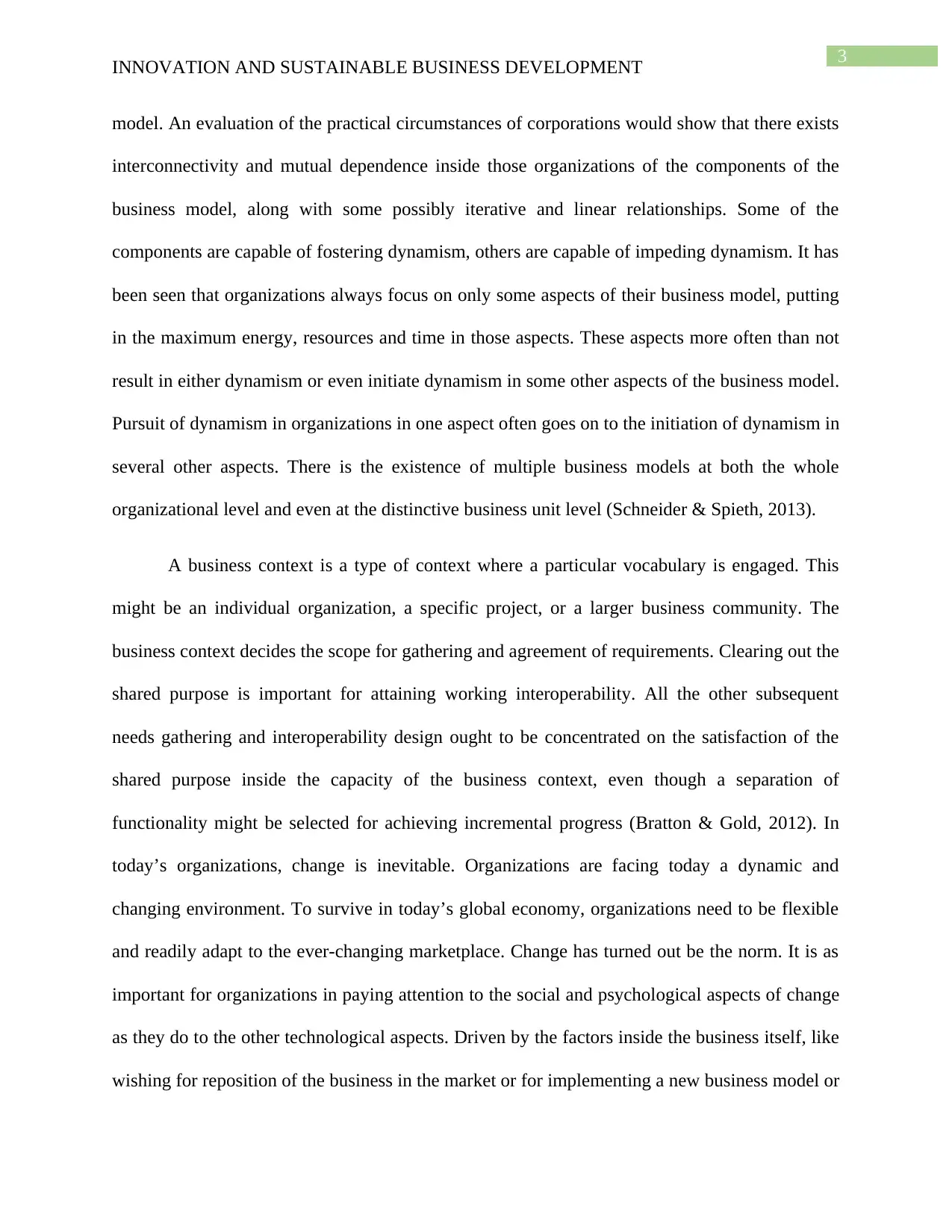
3
INNOVATION AND SUSTAINABLE BUSINESS DEVELOPMENT
model. An evaluation of the practical circumstances of corporations would show that there exists
interconnectivity and mutual dependence inside those organizations of the components of the
business model, along with some possibly iterative and linear relationships. Some of the
components are capable of fostering dynamism, others are capable of impeding dynamism. It has
been seen that organizations always focus on only some aspects of their business model, putting
in the maximum energy, resources and time in those aspects. These aspects more often than not
result in either dynamism or even initiate dynamism in some other aspects of the business model.
Pursuit of dynamism in organizations in one aspect often goes on to the initiation of dynamism in
several other aspects. There is the existence of multiple business models at both the whole
organizational level and even at the distinctive business unit level (Schneider & Spieth, 2013).
A business context is a type of context where a particular vocabulary is engaged. This
might be an individual organization, a specific project, or a larger business community. The
business context decides the scope for gathering and agreement of requirements. Clearing out the
shared purpose is important for attaining working interoperability. All the other subsequent
needs gathering and interoperability design ought to be concentrated on the satisfaction of the
shared purpose inside the capacity of the business context, even though a separation of
functionality might be selected for achieving incremental progress (Bratton & Gold, 2012). In
today’s organizations, change is inevitable. Organizations are facing today a dynamic and
changing environment. To survive in today’s global economy, organizations need to be flexible
and readily adapt to the ever-changing marketplace. Change has turned out be the norm. It is as
important for organizations in paying attention to the social and psychological aspects of change
as they do to the other technological aspects. Driven by the factors inside the business itself, like
wishing for reposition of the business in the market or for implementing a new business model or
INNOVATION AND SUSTAINABLE BUSINESS DEVELOPMENT
model. An evaluation of the practical circumstances of corporations would show that there exists
interconnectivity and mutual dependence inside those organizations of the components of the
business model, along with some possibly iterative and linear relationships. Some of the
components are capable of fostering dynamism, others are capable of impeding dynamism. It has
been seen that organizations always focus on only some aspects of their business model, putting
in the maximum energy, resources and time in those aspects. These aspects more often than not
result in either dynamism or even initiate dynamism in some other aspects of the business model.
Pursuit of dynamism in organizations in one aspect often goes on to the initiation of dynamism in
several other aspects. There is the existence of multiple business models at both the whole
organizational level and even at the distinctive business unit level (Schneider & Spieth, 2013).
A business context is a type of context where a particular vocabulary is engaged. This
might be an individual organization, a specific project, or a larger business community. The
business context decides the scope for gathering and agreement of requirements. Clearing out the
shared purpose is important for attaining working interoperability. All the other subsequent
needs gathering and interoperability design ought to be concentrated on the satisfaction of the
shared purpose inside the capacity of the business context, even though a separation of
functionality might be selected for achieving incremental progress (Bratton & Gold, 2012). In
today’s organizations, change is inevitable. Organizations are facing today a dynamic and
changing environment. To survive in today’s global economy, organizations need to be flexible
and readily adapt to the ever-changing marketplace. Change has turned out be the norm. It is as
important for organizations in paying attention to the social and psychological aspects of change
as they do to the other technological aspects. Driven by the factors inside the business itself, like
wishing for reposition of the business in the market or for implementing a new business model or
Paraphrase This Document
Need a fresh take? Get an instant paraphrase of this document with our AI Paraphraser
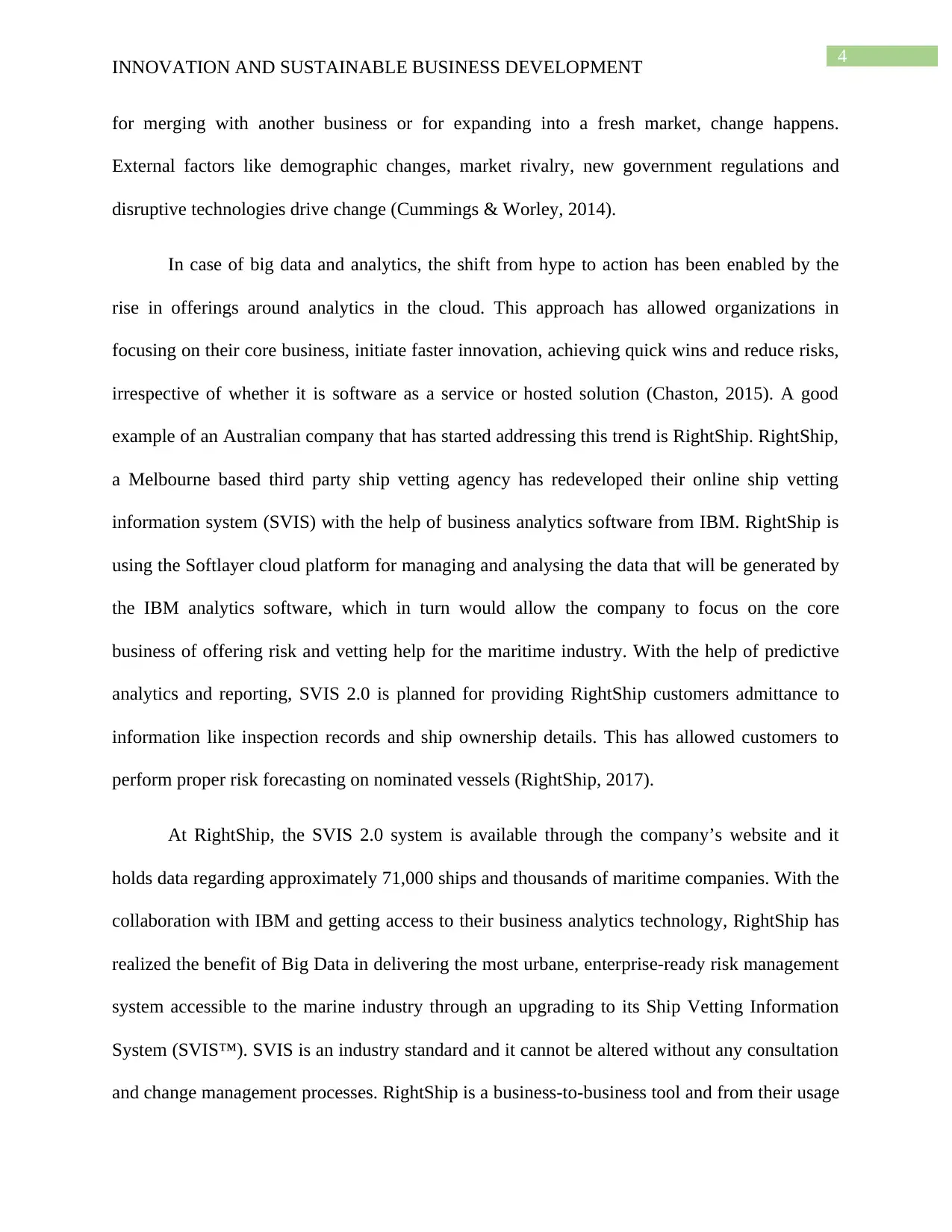
4
INNOVATION AND SUSTAINABLE BUSINESS DEVELOPMENT
for merging with another business or for expanding into a fresh market, change happens.
External factors like demographic changes, market rivalry, new government regulations and
disruptive technologies drive change (Cummings & Worley, 2014).
In case of big data and analytics, the shift from hype to action has been enabled by the
rise in offerings around analytics in the cloud. This approach has allowed organizations in
focusing on their core business, initiate faster innovation, achieving quick wins and reduce risks,
irrespective of whether it is software as a service or hosted solution (Chaston, 2015). A good
example of an Australian company that has started addressing this trend is RightShip. RightShip,
a Melbourne based third party ship vetting agency has redeveloped their online ship vetting
information system (SVIS) with the help of business analytics software from IBM. RightShip is
using the Softlayer cloud platform for managing and analysing the data that will be generated by
the IBM analytics software, which in turn would allow the company to focus on the core
business of offering risk and vetting help for the maritime industry. With the help of predictive
analytics and reporting, SVIS 2.0 is planned for providing RightShip customers admittance to
information like inspection records and ship ownership details. This has allowed customers to
perform proper risk forecasting on nominated vessels (RightShip, 2017).
At RightShip, the SVIS 2.0 system is available through the company’s website and it
holds data regarding approximately 71,000 ships and thousands of maritime companies. With the
collaboration with IBM and getting access to their business analytics technology, RightShip has
realized the benefit of Big Data in delivering the most urbane, enterprise-ready risk management
system accessible to the marine industry through an upgrading to its Ship Vetting Information
System (SVIS™). SVIS is an industry standard and it cannot be altered without any consultation
and change management processes. RightShip is a business-to-business tool and from their usage
INNOVATION AND SUSTAINABLE BUSINESS DEVELOPMENT
for merging with another business or for expanding into a fresh market, change happens.
External factors like demographic changes, market rivalry, new government regulations and
disruptive technologies drive change (Cummings & Worley, 2014).
In case of big data and analytics, the shift from hype to action has been enabled by the
rise in offerings around analytics in the cloud. This approach has allowed organizations in
focusing on their core business, initiate faster innovation, achieving quick wins and reduce risks,
irrespective of whether it is software as a service or hosted solution (Chaston, 2015). A good
example of an Australian company that has started addressing this trend is RightShip. RightShip,
a Melbourne based third party ship vetting agency has redeveloped their online ship vetting
information system (SVIS) with the help of business analytics software from IBM. RightShip is
using the Softlayer cloud platform for managing and analysing the data that will be generated by
the IBM analytics software, which in turn would allow the company to focus on the core
business of offering risk and vetting help for the maritime industry. With the help of predictive
analytics and reporting, SVIS 2.0 is planned for providing RightShip customers admittance to
information like inspection records and ship ownership details. This has allowed customers to
perform proper risk forecasting on nominated vessels (RightShip, 2017).
At RightShip, the SVIS 2.0 system is available through the company’s website and it
holds data regarding approximately 71,000 ships and thousands of maritime companies. With the
collaboration with IBM and getting access to their business analytics technology, RightShip has
realized the benefit of Big Data in delivering the most urbane, enterprise-ready risk management
system accessible to the marine industry through an upgrading to its Ship Vetting Information
System (SVIS™). SVIS is an industry standard and it cannot be altered without any consultation
and change management processes. RightShip is a business-to-business tool and from their usage
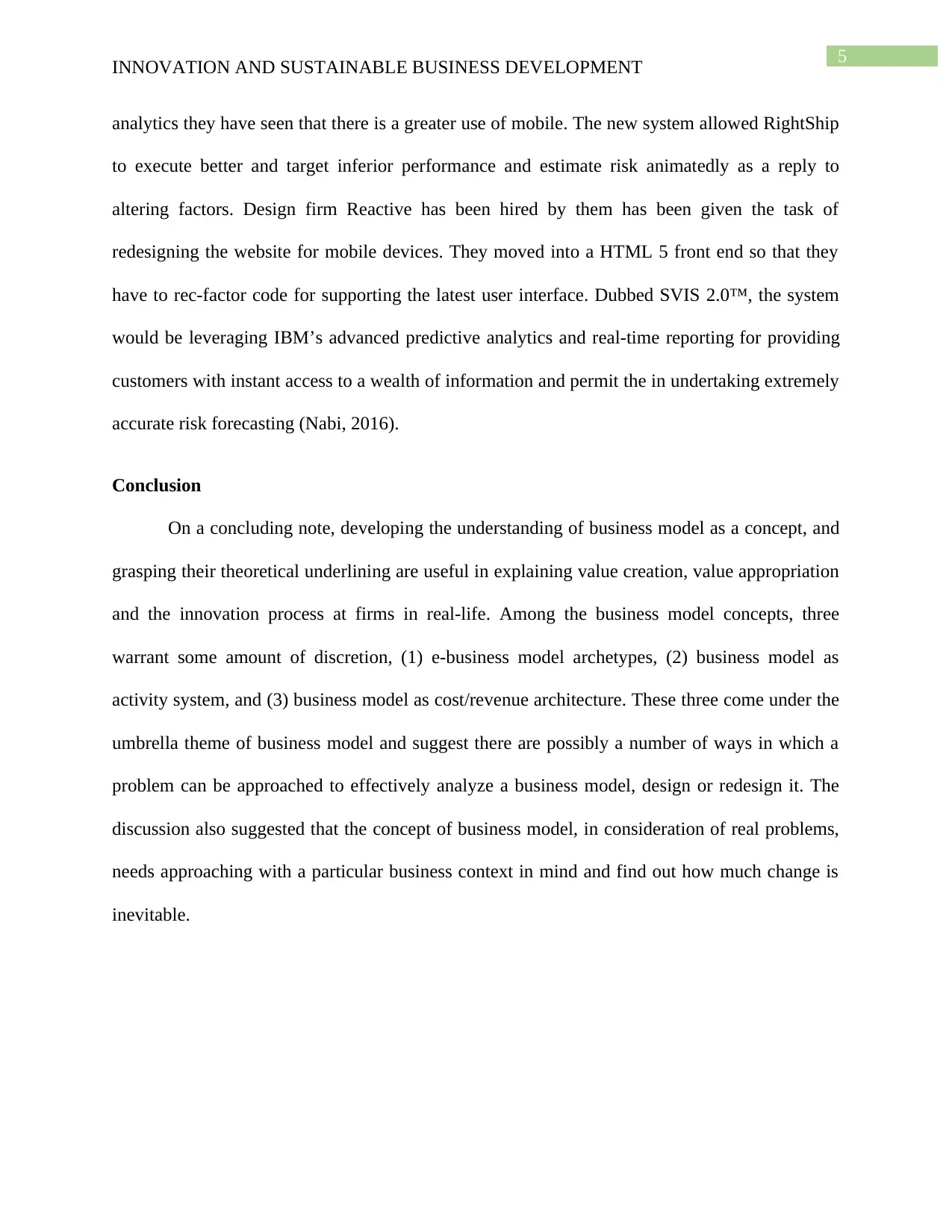
5
INNOVATION AND SUSTAINABLE BUSINESS DEVELOPMENT
analytics they have seen that there is a greater use of mobile. The new system allowed RightShip
to execute better and target inferior performance and estimate risk animatedly as a reply to
altering factors. Design firm Reactive has been hired by them has been given the task of
redesigning the website for mobile devices. They moved into a HTML 5 front end so that they
have to rec-factor code for supporting the latest user interface. Dubbed SVIS 2.0™, the system
would be leveraging IBM’s advanced predictive analytics and real-time reporting for providing
customers with instant access to a wealth of information and permit the in undertaking extremely
accurate risk forecasting (Nabi, 2016).
Conclusion
On a concluding note, developing the understanding of business model as a concept, and
grasping their theoretical underlining are useful in explaining value creation, value appropriation
and the innovation process at firms in real-life. Among the business model concepts, three
warrant some amount of discretion, (1) e-business model archetypes, (2) business model as
activity system, and (3) business model as cost/revenue architecture. These three come under the
umbrella theme of business model and suggest there are possibly a number of ways in which a
problem can be approached to effectively analyze a business model, design or redesign it. The
discussion also suggested that the concept of business model, in consideration of real problems,
needs approaching with a particular business context in mind and find out how much change is
inevitable.
INNOVATION AND SUSTAINABLE BUSINESS DEVELOPMENT
analytics they have seen that there is a greater use of mobile. The new system allowed RightShip
to execute better and target inferior performance and estimate risk animatedly as a reply to
altering factors. Design firm Reactive has been hired by them has been given the task of
redesigning the website for mobile devices. They moved into a HTML 5 front end so that they
have to rec-factor code for supporting the latest user interface. Dubbed SVIS 2.0™, the system
would be leveraging IBM’s advanced predictive analytics and real-time reporting for providing
customers with instant access to a wealth of information and permit the in undertaking extremely
accurate risk forecasting (Nabi, 2016).
Conclusion
On a concluding note, developing the understanding of business model as a concept, and
grasping their theoretical underlining are useful in explaining value creation, value appropriation
and the innovation process at firms in real-life. Among the business model concepts, three
warrant some amount of discretion, (1) e-business model archetypes, (2) business model as
activity system, and (3) business model as cost/revenue architecture. These three come under the
umbrella theme of business model and suggest there are possibly a number of ways in which a
problem can be approached to effectively analyze a business model, design or redesign it. The
discussion also suggested that the concept of business model, in consideration of real problems,
needs approaching with a particular business context in mind and find out how much change is
inevitable.
⊘ This is a preview!⊘
Do you want full access?
Subscribe today to unlock all pages.

Trusted by 1+ million students worldwide
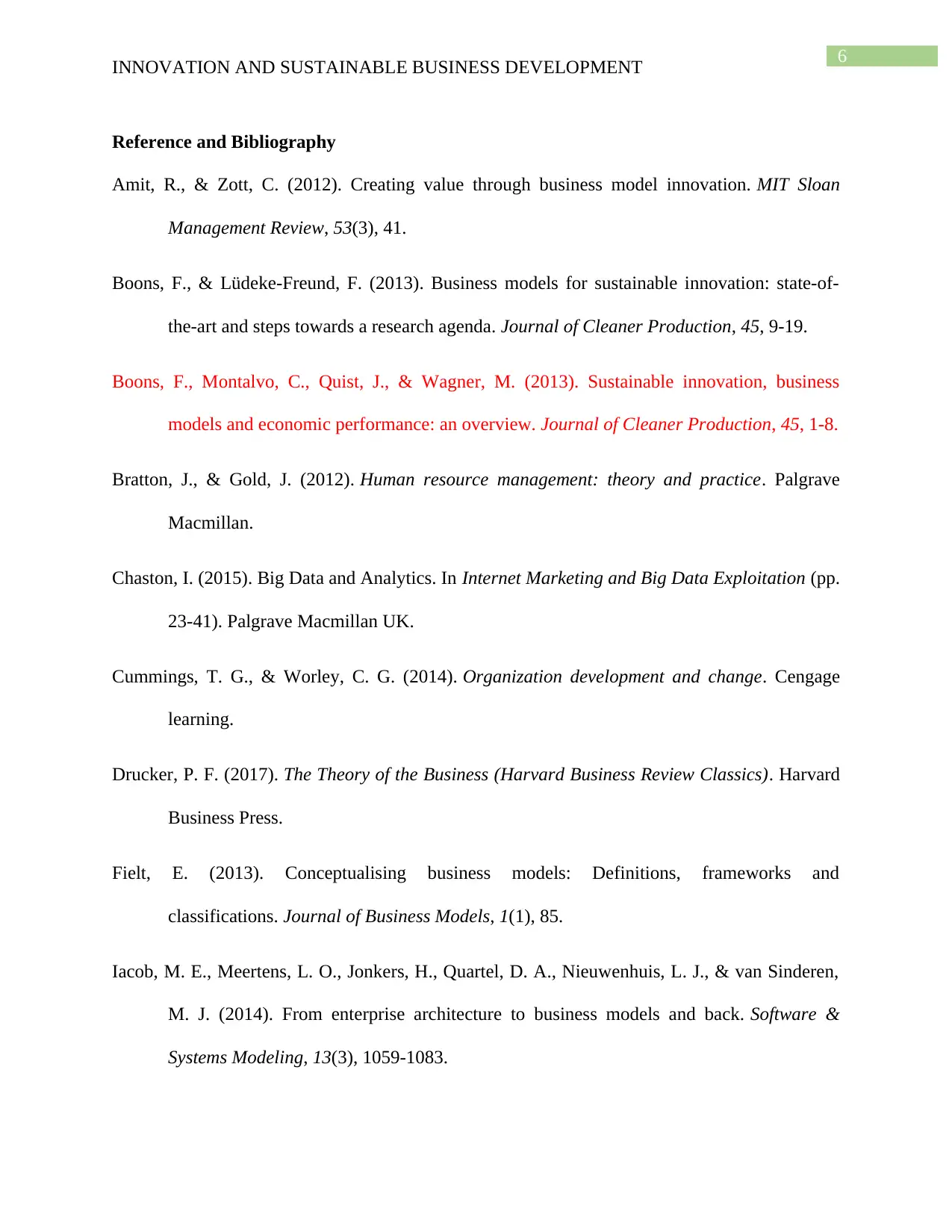
6
INNOVATION AND SUSTAINABLE BUSINESS DEVELOPMENT
Reference and Bibliography
Amit, R., & Zott, C. (2012). Creating value through business model innovation. MIT Sloan
Management Review, 53(3), 41.
Boons, F., & Lüdeke-Freund, F. (2013). Business models for sustainable innovation: state-of-
the-art and steps towards a research agenda. Journal of Cleaner Production, 45, 9-19.
Boons, F., Montalvo, C., Quist, J., & Wagner, M. (2013). Sustainable innovation, business
models and economic performance: an overview. Journal of Cleaner Production, 45, 1-8.
Bratton, J., & Gold, J. (2012). Human resource management: theory and practice. Palgrave
Macmillan.
Chaston, I. (2015). Big Data and Analytics. In Internet Marketing and Big Data Exploitation (pp.
23-41). Palgrave Macmillan UK.
Cummings, T. G., & Worley, C. G. (2014). Organization development and change. Cengage
learning.
Drucker, P. F. (2017). The Theory of the Business (Harvard Business Review Classics). Harvard
Business Press.
Fielt, E. (2013). Conceptualising business models: Definitions, frameworks and
classifications. Journal of Business Models, 1(1), 85.
Iacob, M. E., Meertens, L. O., Jonkers, H., Quartel, D. A., Nieuwenhuis, L. J., & van Sinderen,
M. J. (2014). From enterprise architecture to business models and back. Software &
Systems Modeling, 13(3), 1059-1083.
INNOVATION AND SUSTAINABLE BUSINESS DEVELOPMENT
Reference and Bibliography
Amit, R., & Zott, C. (2012). Creating value through business model innovation. MIT Sloan
Management Review, 53(3), 41.
Boons, F., & Lüdeke-Freund, F. (2013). Business models for sustainable innovation: state-of-
the-art and steps towards a research agenda. Journal of Cleaner Production, 45, 9-19.
Boons, F., Montalvo, C., Quist, J., & Wagner, M. (2013). Sustainable innovation, business
models and economic performance: an overview. Journal of Cleaner Production, 45, 1-8.
Bratton, J., & Gold, J. (2012). Human resource management: theory and practice. Palgrave
Macmillan.
Chaston, I. (2015). Big Data and Analytics. In Internet Marketing and Big Data Exploitation (pp.
23-41). Palgrave Macmillan UK.
Cummings, T. G., & Worley, C. G. (2014). Organization development and change. Cengage
learning.
Drucker, P. F. (2017). The Theory of the Business (Harvard Business Review Classics). Harvard
Business Press.
Fielt, E. (2013). Conceptualising business models: Definitions, frameworks and
classifications. Journal of Business Models, 1(1), 85.
Iacob, M. E., Meertens, L. O., Jonkers, H., Quartel, D. A., Nieuwenhuis, L. J., & van Sinderen,
M. J. (2014). From enterprise architecture to business models and back. Software &
Systems Modeling, 13(3), 1059-1083.
Paraphrase This Document
Need a fresh take? Get an instant paraphrase of this document with our AI Paraphraser
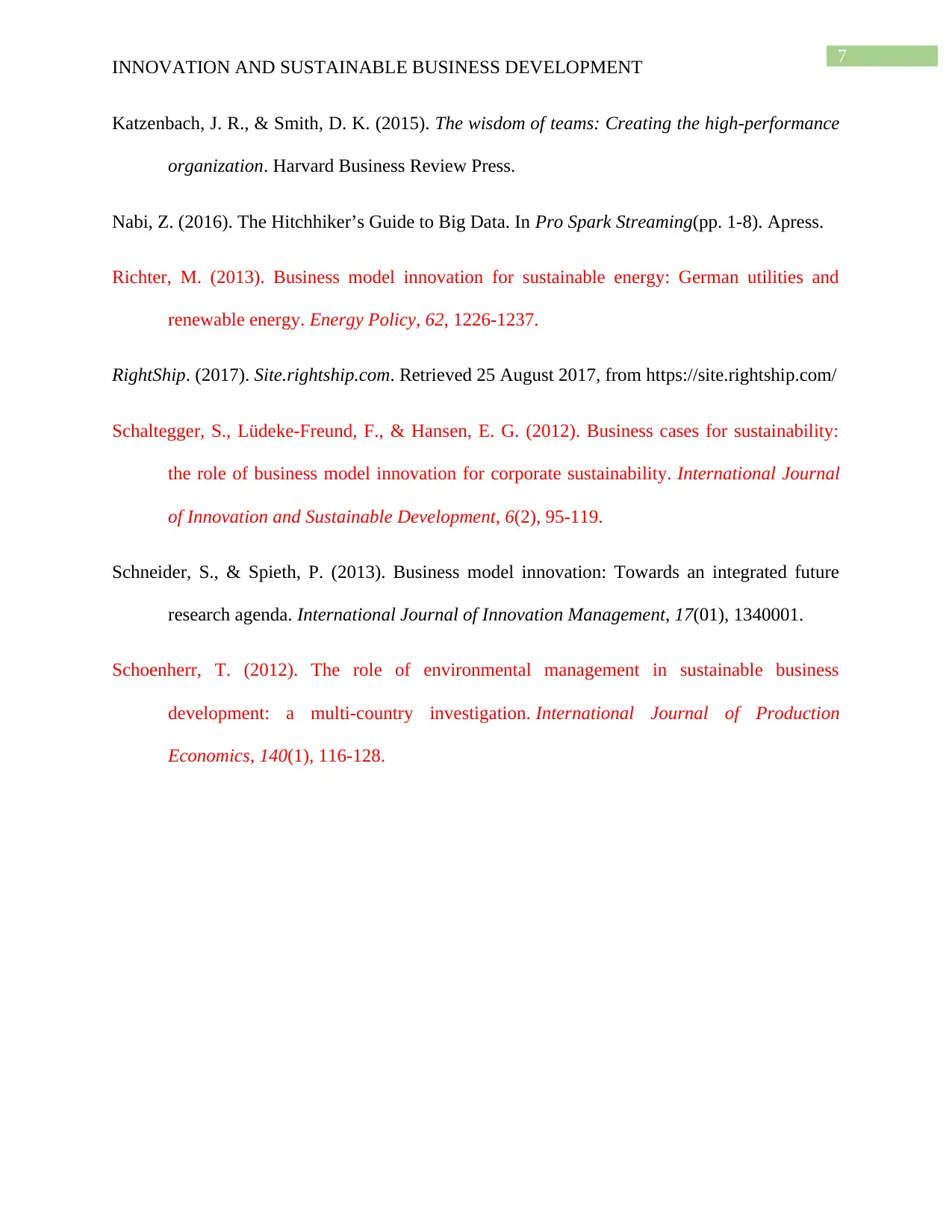
7
INNOVATION AND SUSTAINABLE BUSINESS DEVELOPMENT
Katzenbach, J. R., & Smith, D. K. (2015). The wisdom of teams: Creating the high-performance
organization. Harvard Business Review Press.
Nabi, Z. (2016). The Hitchhiker’s Guide to Big Data. In Pro Spark Streaming(pp. 1-8). Apress.
Richter, M. (2013). Business model innovation for sustainable energy: German utilities and
renewable energy. Energy Policy, 62, 1226-1237.
RightShip. (2017). Site.rightship.com. Retrieved 25 August 2017, from https://site.rightship.com/
Schaltegger, S., Lüdeke-Freund, F., & Hansen, E. G. (2012). Business cases for sustainability:
the role of business model innovation for corporate sustainability. International Journal
of Innovation and Sustainable Development, 6(2), 95-119.
Schneider, S., & Spieth, P. (2013). Business model innovation: Towards an integrated future
research agenda. International Journal of Innovation Management, 17(01), 1340001.
Schoenherr, T. (2012). The role of environmental management in sustainable business
development: a multi-country investigation. International Journal of Production
Economics, 140(1), 116-128.
INNOVATION AND SUSTAINABLE BUSINESS DEVELOPMENT
Katzenbach, J. R., & Smith, D. K. (2015). The wisdom of teams: Creating the high-performance
organization. Harvard Business Review Press.
Nabi, Z. (2016). The Hitchhiker’s Guide to Big Data. In Pro Spark Streaming(pp. 1-8). Apress.
Richter, M. (2013). Business model innovation for sustainable energy: German utilities and
renewable energy. Energy Policy, 62, 1226-1237.
RightShip. (2017). Site.rightship.com. Retrieved 25 August 2017, from https://site.rightship.com/
Schaltegger, S., Lüdeke-Freund, F., & Hansen, E. G. (2012). Business cases for sustainability:
the role of business model innovation for corporate sustainability. International Journal
of Innovation and Sustainable Development, 6(2), 95-119.
Schneider, S., & Spieth, P. (2013). Business model innovation: Towards an integrated future
research agenda. International Journal of Innovation Management, 17(01), 1340001.
Schoenherr, T. (2012). The role of environmental management in sustainable business
development: a multi-country investigation. International Journal of Production
Economics, 140(1), 116-128.
1 out of 8
Related Documents
Your All-in-One AI-Powered Toolkit for Academic Success.
+13062052269
info@desklib.com
Available 24*7 on WhatsApp / Email
![[object Object]](/_next/static/media/star-bottom.7253800d.svg)
Unlock your academic potential
Copyright © 2020–2025 A2Z Services. All Rights Reserved. Developed and managed by ZUCOL.





